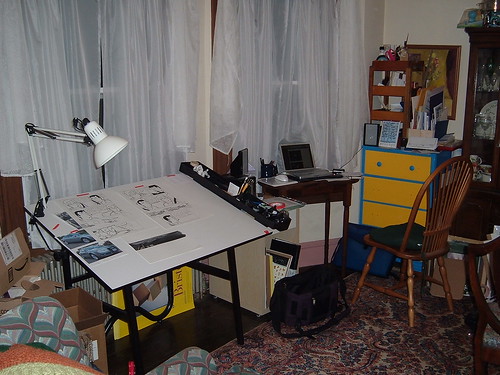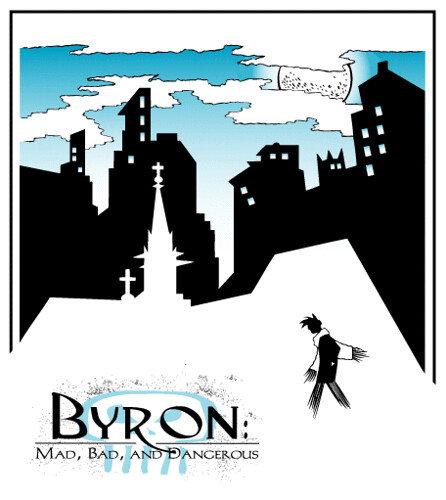
My studio, wedged between the china cabinet & a recliner.
Comics: Catfight, Pale Fire, Cross Country
Website: mkreed.com
Making comics since year of:stories since roughly 2000, little stuff since I was a kid
Art education/schools attended: attended Syracuse University, but for English, not art, just snuck art classes in where I could
Tools
Pencils: I use mechanical pencils, usually .07 lead of various brands & types, or 2.0 Steadler HB, and I pretty much always sketch with blue lead. I have a stash.
Inks: P.H. Martin's Black Star Matte. Some P.H. Martin's transparent watercolors for greys, and recently I've been trying tubes of Windsor Newton watercolors for grey tones as well.
Brushes: Raphael 8404, usually #0, for lines. Crappy synthetic nylons for watercolors. (for now, I'm still experimentig, but I don't want to ruin brushes that cost $10+ when I don't know what the difference is. Once I get used to painting with watercolors, I'll upgrade.
Pens: Faber Castell Pitt pens, for lettering, and sometimes in lieu of brushes. I have a Pentel Japanese brush pen that puts down very lovely lines, but I have yet to use it for anything beyond sketching. I've also tried the G nibs & have been considering makeing more regular use of them.
Paper: Strathmore 300 plate, and my usual pages are on 11x 17. For special occasions, I'll upgrade, and go for 400 or 500. (I made this as a wedding present and I think it was on 500 2 ply.)
Lettering: Faber Castell Pitt Medium/Fine pen. Usually without a guide.
Color: I don't often use color. It's nerve wracking when I do. I've used Photoshop, and I've used Gouache. I prefer doing it by hand where I can.
Layout/ Composition: I write everything in my sketchbook & do the layout as I write. Usually by the time I've writen something down, I've thought about it for so long that I don't do many revisions.
Convention Sketches (when different from illustrations done in the studio): Depends on what I have in the lunchbox. My favorite writing pen is the super thin Uniball Vision Elite with Blue/Black ink. (That's not Blue or Black. They make a Blue/Black. It's gorgous.) I almost always have it on me and it's usually the first thing I grab, if not it's probably a Pitt brush pen. I sometimes pencil, and sometimes don't. For regular notebook sketching, I use a Pentel mechanical .07 pencil & non-photo blue lead, because it smudges much less.
Tool timeline, starting from when you began drawing in any serious way until the present, and what spurred the changes: Oh boy, this is a lot of asking questions & self discovery, as I didn't have much formal art training aside from high school, where I mostly spent time in the photo lab... In high school, the notes I wrote to my friends were comics in pencil & pen on notebook or computer paper, but when I first started making stories, I used black colored pencil. Amazingly, these scanned, but didn't look super hot. I started combining Microns, and then started using a Hunt-Speedball nib & Bienfang bristol. (This was what was in the basement art supply section at Syracuse. I used Higgins Black Magic for years, not realising there were vastly superior inks to be had. I switched to brushes & continued, as the line was much nicer, ever though I used crappy synthetic "white sable" brushes. This continued until I finished my first book, Catfight, and is part of why it looks so crappy. Oh! I started the book on Bienfang bristol, but moved home & only found Strathmore in the right size. (Or Strathmore was cheaper, I forget exactly.) By the time I finished the book a year later, the Bienfang paper was noticably more yellow than the Strathmore. Now I try to store pages in the dark so light won't affect them.
At some point before I began my next book, I started asking other people about what they used to make comics. I read the Cerebus Guide to Self Publishing, but disregarded Dave Sims' advice on brushes, because from using the brush enough, I though he was full of BS on the thing about the nibs. You can get around stuff with practice, or at least get to the point that you know your brushes well enough that you get a sense when you need to do things to avoid split hairs & such. They just take more attention & care. Anyhow, among other indie comics alumni Jim Rugg gave me some advice on inks. I tried out a whole bunch, and decided to stick with P.H. Martin's Black Star Matte. I tried using W&N's Series 7, but then my boyfriend's buddy Farel Dalrymple told me about the Raphael 8404 brushes, which I could tell when I touched the bristle were made from much nicer stuff. Todd Webb is actually sponsored by Faber Castell, as he only uses the Pitt brush pens, and will let anyone try one.
For my new book, I started out inking with Pitt pens, but it doesn't have the same feel as brushes, and while I can do pages faster with them, I hate using them. Just not as fun on a whole page. I've been using watercolors over them for grey tones, and I've been liking how they look much more. (The home page of my website has an example.)
Then I started this blog, and since then, I've tried using the G-nibs, which I like, but not more than brushes. And I've used the Pentel Japense Brush Pen, which is the nicest brush pen I've tried yet. I've also been trying out watercolor paper, but have no opinions yet.
What tools you'd never use, and why: Microns & Sharpies bleed too much. Adobe Illustrator sucks the fun out of everything. My Wacom tablet, it's just my mouse. That's all I've used it for in like three years. Speedball nibs I think will eventually drive anyone insane. Higgins ink when I want solid blacks.
And lastly, any advice you'd like to give: Don't go out and buy a $20 brush when you don't know what a $2 brush is like. Buy the cheap stuff and upgrade when you've gotten better with them. Then when you get a better brush, you'll know what the difference is & won't kill some expensive stuff with your crappy beginnings & lack of care.
Give yourself a nice setup to work in. It makes it much easier to stay at your desk when you have a place for your tea, an audiobook loaded up on your stereo, and a stack of bristol right next to you. Also it gives you fewer excuses to get up.
Listen to audiobooks, especially long books that would otherwise take you a while to read. Music is too easy to get up from, but good stories are harder to take a break from.
Set a realistic schedule & stick to it, but don't let yourself get burnt out. Take breaks when you need to, but don't get lazy.
Be a shameless self promoter.

